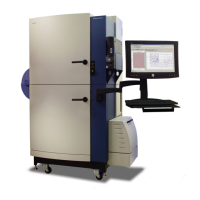System Hardware Features
26 0112-0109 H
Pipettor operations are controlled from within ScreenWorks Software
protocols, or some operations, for example, loading tips, can be
performed individually, directly through commands in the Instrument
menu. Connectors on the back of the pipettor head identify the head
format as 1536, 384, or 96 tips, so ScreenWorks Software only offers
valid plate formats and pipetting parameters for protocol setup.
The standard pipettor head uses air displacement to control aspiration
and dispense speed and volume. The volume of compound to be
transferred is configured in the software, and it is possible to draw
compound from multiple source plates to dispense into one destination
plate, or to aspirate from one plate and dispense to multiple well plates
or quadrants.
The 96- and 384-pipettor heads displace air in the disposable pipette
tips. In the 1536-pipettor head a plunger for each of the 1536 tips
presses against an elastic gasket seated on the tip block. When the
plungers move down they create an initial seal between the gasket and
tip block. Once the seal is created, further plunger movement causes
air displacement in the tip block (see Figure 2-4).
Figure 2-4 Seal creation in the 1536-pipettor head.
Minimum pipettor precision is as follows:
• 3% for 75 μL additions (96-well).
• 4% for 25 μL additions (384-well)
• 6% for 3 μL additions (1536-well)
Performance is dependent on tip/gasket seating and can be
compromised if the seal is broken. Use only Molecular Devices
recommended tips and gaskets to ensure the highest accuracy and to
reduce the possibility of damaging the pipettor. See Appendix C:

